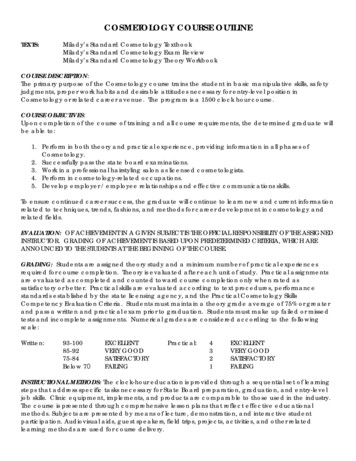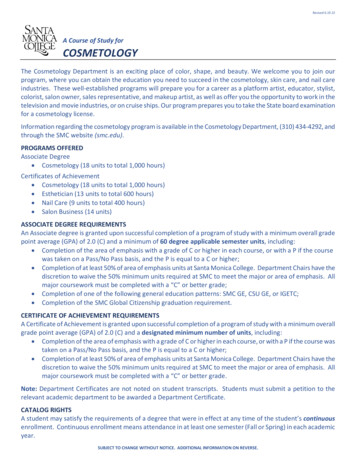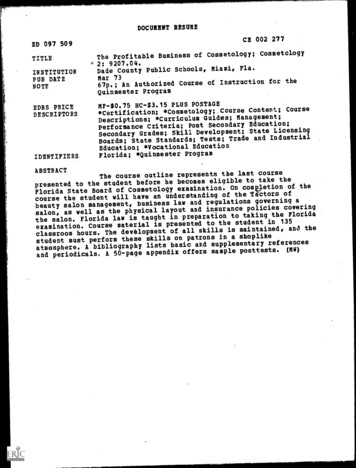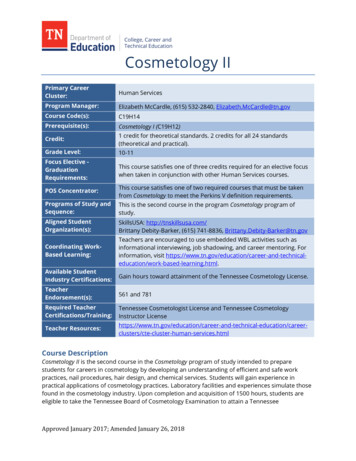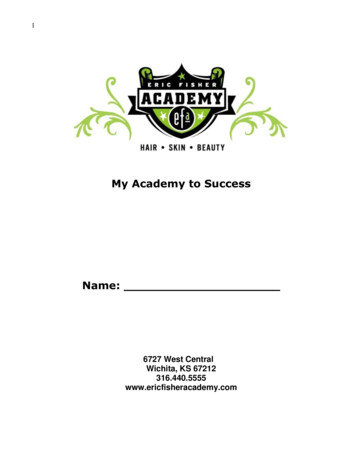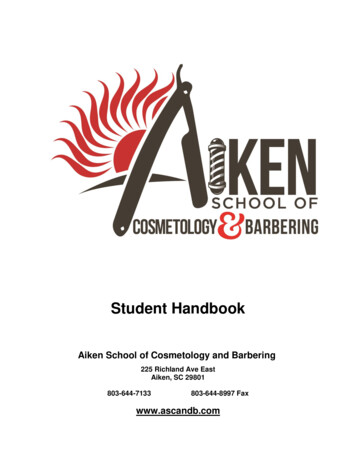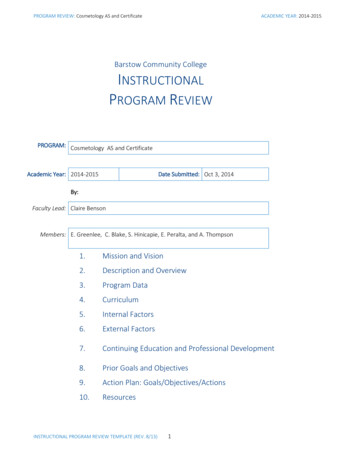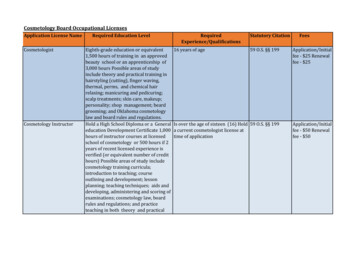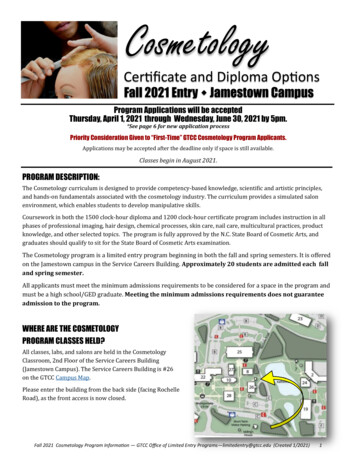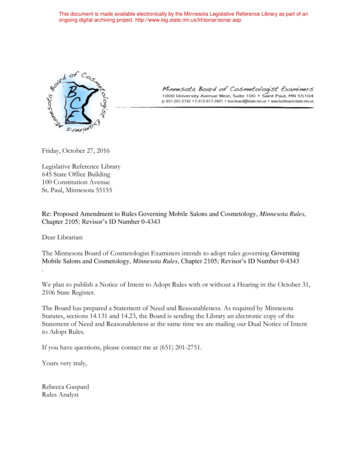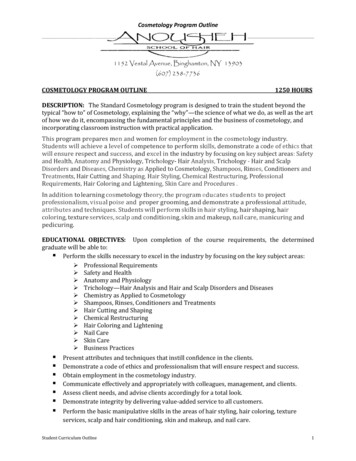
Transcription
Cosmetology Program Outline1152 Vestal Avenue, Binghamton, NY 13903(607) 238-7736COSMETOLOGY PROGRAM OUTLINE1250 HOURSDESCRIPTION: The Standard Cosmetology program is designed to train the student beyond thetypical “how to” of Cosmetology, explaining the “why”—the science of what we do, as well as the artof how we do it, encompassing the fundamental principles and the business of cosmetology, andincorporating classroom instruction with practical application.This program prepares men and women for employment in the cosmetology industry.Students will achieve a level of competence to perform skills, demonstrate a code of ethics thatwill ensure respect and success, and excel in the industry by focusing on key subject areas: Safetyand Health, Anatomy and Physiology, Trichology- Hair Analysis, Trichology - Hair and ScalpDisorders and Diseases, Chemistry as Applied to Cosmetology, Shampoos, Rinses, Conditioners andTreatments, Hair Cutting and Shaping, Hair Styling, Chemical Restructuring, ProfessionalRequirements, Hair Coloring and Lightening, Skin Care and Procedures .In addition to learning cosmetology theory, the program educates students to projectprofessionalism, visual poise and proper grooming, and demonstrate a professional attitude,attributes and techniques. Students will perform skills in hair styling, hair shaping, haircoloring, texture services, scalp and conditioning, skin and makeup, nail care, manicuring andpedicuring.EDUCATIONAL OBJECTIVES: Upon completion of the course requirements, the determinedgraduate will be able to: Perform the skills necessary to excel in the industry by focusing on the key subject areas: Professional Requirements Safety and Health Anatomy and Physiology Trichology—Hair Analysis and Hair and Scalp Disorders and Diseases Chemistry as Applied to Cosmetology Shampoos, Rinses, Conditioners and Treatments Hair Cutting and Shaping Chemical Restructuring Hair Coloring and Lightening Nail Care Skin Care Business Practices Present attributes and techniques that instill confidence in the clients.Demonstrate a code of ethics and professionalism that will ensure respect and success.Obtain employment in the cosmetology industry.Communicate effectively and appropriately with colleagues, management, and clients.Assess client needs, and advise clients accordingly for a total look.Demonstrate integrity by delivering value-added service to all customers.Perform the basic manipulative skills in the areas of hair styling, hair coloring, textureservices, scalp and hair conditioning, skin and makeup, and nail care.Student Curriculum Outline1
PROFESSIONAL REQUIREMENTS—24 Hours New York State/Pennsylvania License Requirements State and Federal Payroll Requirements New York State/Pennsylvania Sales Tax Requirements Career Opportunities and Placement Professional Ethics, Conduct and Attitude Professional Organizations, Trade Shows and PublicationsSAFETY AND HEALTH — 26 Hours New York State/Pennsylvania Laws, Rules and Regulations OSHA Regulations Concerning Hazardous Materials Communications Types and Classification of Infectious Organisms Growth and Reproduction of Infectious Organisms Infections and Their Prevention Immunity and Body Defenses Decontamination and Infection Control Physical and Chemical AgentsANATOMY AND PHYSIOLOGY — 50 Hours Importance of Anatomy and Physiology to the Cosmetology Profession Histology-Cells, Tissues and Organs Body Systems Basic Principles of Nutrition Overview of Bones and Muscles of the Head, Arms, Hands, Legs and Feet Structure and Functions of the SkinTRICHOLOGY—HAIR ANALYSIS — 20 Hours Structure Growth Patterns Texture Porosity Elasticity Growth and Loss Hair Loss Treatment OptionsTRICHOLOGY—HAIR AND SCALP DISORDERS AND DISEASES — 30 Hours Dandruff Alopecia Fungal Infections Infestations InfectionsCHEMISTRY AS APPLIED TO COSMETOLOGY — 50 Hours Types and Classification of Bacteria Forms and Properties of Matter Bacteria Growth and Reproduction Parasites in the Salon Environment Infectious Disease Transmittal Elements, Compounds and Mixtures Chemical Reactions and Solutions The pH Scale FDA Laws Governing Hair Care Products and Product Safety Sanitizing and Disinfecting Salon Tools and Surfaces Purpose and Uses of MSDS Basics of Electricity and Light TherapyStudent Curriculum Outline2
SHAMPOOS, RINSES, CONDITIONERS AND TREATMENTS — 50 Hours Client Preparation, Analysis and Consultation Hair Analysis Instruments and Equipment Shampooing Products, Composition and Procedures Rinsing Products, Composition and Procedures Conditioning Products, Composition and Procedures Procedures for Hair and Scalp Disorders Scalp ManipulationsHAIR CUTTING AND SHAPING — 205 Hours Fundamentals, Principles and Concepts of Design Scissor Haircutting Nomenclature and Care of Scissors Techniques and Procedures Razor Haircutting Nomenclature and Care of Razor Techniques and Procedures Clipper Haircutting Nomenclature and Care of Tools Techniques and Procedures Removal/Trim of Superfluous Hair Contemporary and Specialized Haircutting Female Styles Male Styles Children Styles Mustache and Beard Shaping Shaving Dexterity of the Hands and Razor Preparation and ProceduresHAIR STYLING — 245 Hours Fingerwaving Pincurling Skipwaving Roller Styling Patterns in Hairstyling Waves, Pin Curls, Rollers and Combinations Finishing Techniques Twisting, Wrapping, Weaving, Extending, Locking and Braiding Traditional Weaving and Styling Services in Hairstyling Tools and Implements Blowdrying Thermal Curling Hair Pressing Hair PiecesCHEMICAL RESTRUCTURING — 180 Hours Chemistry Chemical Restructuring Products Client Consultation Preliminary Procedure of Chemical Restructuring Procedure of Chemical Restructuring Corrective Chemical RestructuringStudent Curriculum Outline3
HAIR COLORING AND LIGHTENING — 200 Hours Color Theory Chemistry Preliminary Procedures of Hair Coloring Client Consultation Hair Coloring Procedures Hair Lightening Special Effects Corrective ProceduresNAIL CARE AND PROCEDURES — 40 Hours Nail Structure Nail Disorders and Diseases Nail Shape and Color Analysis Basic Manicuring Manipulations of the Hand and Arm Massage movements and their physiological effects Basic implements, cosmetics and materials used in Manicuring Five basic nail shapes Proper procedures, and sanitary and safety precautionsSKIN CARE AND PROCEDURES — 60 Hours Structure and Function of the Skin Skin Conditions and Disorders Facial and Body Procedures Client Preparation Skin Analysis and Consultation Wet and Dry Exfoliations and Applications Use of Various Products to Enhance the Appearance of the SkinREMOVAL OF SUPERFLUOUS HAIR — 20 Hours Conditions that contraindicate hair removal in the salon Methods of permanent hair removal Techniques of temporary hair removalCLIENT CONSULTATION — 15 Hours Consultation preparation Client needs and desires based on “total look” Fashion and lifestyle choices Previous experiences and expectationsPEDICURING — 20 Hours Nail Structure Nail Disorders and Diseases Manipulations of the Leg and Foot Basic implements, cosmetics and materials used in Pedicuring Proper procedures, and sanitary and safety precautionsBUSINESS PRACTICES AND JOB SKILLS—15 Hours Principals for personal and professional success Long term and short term goals Personal hygiene and professionalism Communication with managers, co-workers and clients Professional image and customer serviceStudent Curriculum Outline4
TEACHING AND LEARNING METHODS: The clock hour education is provided through asequential set of learning steps which address specific tasks necessary for state board preparation,graduation and job entry level skills. Clinic equipment, implements, and products are comparable tothose used in the industry. Each student will receive instruction that relates to the performance ofuseful, creative, and productive career oriented activities. The course is presented throughcomprehensive lesson plans which reflect effective educational methods. Subjects are presented bymeans of interactive lecture, demonstration, cooperative learning, labs, student salon activities, andstudent participation. Audio-visual aids, guest speakers, field trips, projects, activities, and otherrelated learning methods are used throughout the course.GRADING PROCEDURES: The qualitative element used to determine academic progress is areasonable system of grades as determined by assigned academic learning. Students are assignedacademic learning and a minimum number of practical experiences. Academic learning is evaluatedafter each unit of study. Practical assignments are evaluated as completed and counted towardcourse completion only when rated as satisfactory or better (the computer system will reflectcompletion of the practical assignment as a 100% rating). If the performance does not meetsatisfactory requirements, it is not counted and the performance must be repeated. At least twocomprehensive practical skills evaluations will be conducted during the course of study. Practicalskills are evaluated according to text procedures and set forth in practical skills evaluation criteriaadopted by the school. Students must maintain a written grade average of 70% and pass a FINALwritten and practical exam prior to graduation. Students must make up failed or missed tests andincomplete assignments. Numerical grades are considered according to the following scale:90-100 or80-89 or70-79 orBelow-70 Student Curriculum Outline5
Cosmetology Program Outline . 1152 Vestal Avenue, Binghamton, NY 13903 (607) 238-7736. COSMETOLOGY PROGRAM OUTLINE 1250 HOURS . DESCRIPTION: The Standard Cosmetology program is designed to train the student beyond the typical "how to" of Cosmetology, explaining the "why"—the science of what we do, as well as the art
